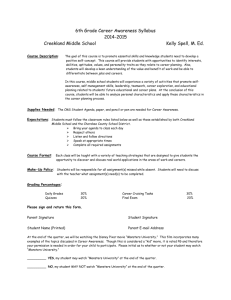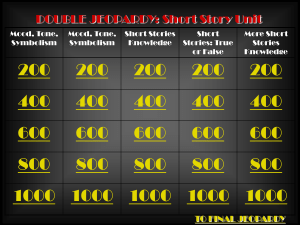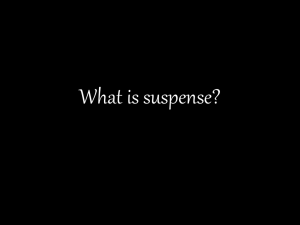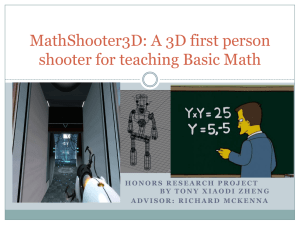Dynamic Curriculum Project 2015 Topic & Grade Level: “The
advertisement
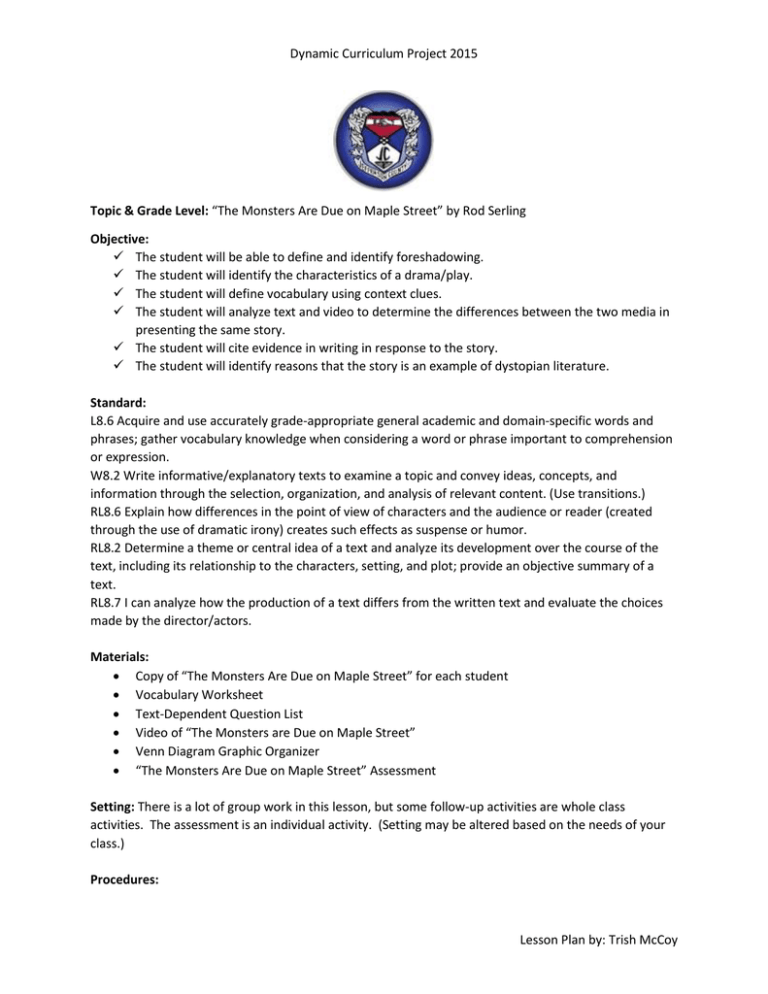
Dynamic Curriculum Project 2015 Topic & Grade Level: “The Monsters Are Due on Maple Street” by Rod Serling Objective: The student will be able to define and identify foreshadowing. The student will identify the characteristics of a drama/play. The student will define vocabulary using context clues. The student will analyze text and video to determine the differences between the two media in presenting the same story. The student will cite evidence in writing in response to the story. The student will identify reasons that the story is an example of dystopian literature. Standard: L8.6 Acquire and use accurately grade-appropriate general academic and domain-specific words and phrases; gather vocabulary knowledge when considering a word or phrase important to comprehension or expression. W8.2 Write informative/explanatory texts to examine a topic and convey ideas, concepts, and information through the selection, organization, and analysis of relevant content. (Use transitions.) RL8.6 Explain how differences in the point of view of characters and the audience or reader (created through the use of dramatic irony) creates such effects as suspense or humor. RL8.2 Determine a theme or central idea of a text and analyze its development over the course of the text, including its relationship to the characters, setting, and plot; provide an objective summary of a text. RL8.7 I can analyze how the production of a text differs from the written text and evaluate the choices made by the director/actors. Materials: Copy of “The Monsters Are Due on Maple Street” for each student Vocabulary Worksheet Text-Dependent Question List Video of “The Monsters are Due on Maple Street” Venn Diagram Graphic Organizer “The Monsters Are Due on Maple Street” Assessment Setting: There is a lot of group work in this lesson, but some follow-up activities are whole class activities. The assessment is an individual activity. (Setting may be altered based on the needs of your class.) Procedures: Lesson Plan by: Trish McCoy Dynamic Curriculum Project 2015 1. Students look at the illustrations for the story and the title and predict what they think will happen. (This can be written on index cards for future use.) 2. Write the following quote by John F. Kennedy on the board and ask students to discuss in pairs what it means and when it would be applicable to life: We have nothing to fear but fear itself. 3. Since there is a lot of vocabulary that might prove challenging for students, use the Vocabulary Worksheet at the point to orient them before they begin reading. 4. Discuss the text features that are present in a play/drama. (stage directions, character names before dialogue, acts and scenes) 5. Students will break into groups of five or six to read the play aloud. (Stage directions will need to be read in order for students to grasp the mood and how the author sets it up.) 6. Call students back to a group or class. Use the text-dependent questions to review the story and deepen understanding of the text. 7. Distribute the Venn Diagram and review how it is used. 8. Play the video and have students complete the diagram to show similarities and difference between the text and the video. 9. Lead students in a discussion of how the story is an example of dystopian literature. 10. Students should be ready for the story assessment. Questions: 1) In the narrator’s introduction, how does the author establish a science fiction genre? (words and phrases like “fifth dimension,” “space between science and superstition,” “imagination,” “twilight zone” 2) After reading the introductory remarks by the narrator, what tone is set for the play in terms of science? In terms of superstition and fear? (Words like pit and fears, summit and knowledge, light and science are paired. Pit and shadow have negative connotations, but light and summit have positive ones. The author paired words that are negative when talking about fears and superstitions, but words that are positive with science and knowledge. The author’s tone toward science is positive.) 3) What is the setting for the play and what does it say about the message the author left you with? (Maple Street is very “ordinary” in terms of a community of a few years ago. There is nothing that makes it any different than many, many other communities across the country, but small, common things, like gossip and suspicion, can develop extreme behavior anywhere and tear communities apart.) 4) What do Steve’s words and reactions reveal about him when he is talking to Tommy? (He is trying to be optimistic and encourage others to prevent hysteria. He finds excuses like a meteor, but he is uncertain which is evident from the ellipses and dashes [writer’s craft]. Students should notice the stage directions that say that he is “trying to weight his words with optimism he doesn’t feel…”) 5) When Tommy says, “They sent four people. A mother and a father and two kids who looked just like humans…but they weren’t,” what is the effect on the crowd? (There is a silence, and Steve wears a “tight grin.” There is a laughter described as “a desperate attempt to lighten the atmosphere.” Even though they find Tommy’s idea outlandish, they still experience fear and/or suspicion. They are becoming fearful, nervous, and suspicious.) Lesson Plan by: Trish McCoy Dynamic Curriculum Project 2015 6) How do people react to Les Goodman on pages 673-674? (His car starting changes their outlook. Someone realizes that he didn’t come out initially. He becomes a target for the mob. Most immediately turn against him, but Steve plays the Devil’s Advocate and tries to defend him.) 7) How are Steve’s words in defense of Les foreshadowing: We’re on a monster kick.. (The monsters are the people who are driven by hysteria and fear.) 8) Why do you think the author chose the word metamorphosis instead of a different word to mean change on page 673? (It is a scientific word. Students may also feel it has a negative connotation since it relates mainly to insects.) 9) On pages 673-675, Les reacts to the crowd. What does he say and what does this reveal about the theme of the play? (Les says, “As God is my witness…you’re letting something begin here that’s a nightmare!” He realizes the destructive pattern of events. This shows the theme that fear and suspicion can overshadow reason and human civility.) 10) At the end of the play, what conclusion do the aliens come to about humanity? (The world is full of Maple Streets and that humanity is its own worst enemy. To destroy humanity, there’s no need for weapons because they can “let them destroy themselves.”) 11) What are the weapons of humanity? How can each destroy? Use specific evidence from the text to support how these weapons can be destructive. (The weapons are “thoughts, attitudes, prejudices...” and “suspicions.” [Thoughts – Tommy’s thoughts of aliens and imposters to look for enemies] [Attitudes – Charlie’s accusations that Goodman is an oddball and that anyone different must be suspicious] [ Prejudices – the dark figure has no chance to be identified before people assume the worst] [Suspicions – the light in the houses cause people to be suspicious of others, think the worst] ) 12) Why is the title appropriate? Who are the monsters? What is the significance of the word Due? (The reader at first believes the monsters are outsiders, like aliens, who will arrive, but the humans themselves become the monsters. The word due emphasizes the author’s idea that the fear of the unknown will inevitably lead to the destruction of civilized behavior unless it is held in check.) Differentiation: Lower-performing students will need extra help with some complex thoughts and concepts, like who the real monsters are and mob hysteria. They will also need assistance with some vocabulary. Higher-performing students could listen to Orwell’s “The War of the Worlds” and discuss how it is related to this story. They could “teach” a class on it in relation to what is learned and gained from “The Monsters are Due on Maple Street.” Assessment: Assessment page attached Resources: “The Monsters Are Due on Maple Street” Video http://www.teachertube.com/video/monsters-are-due1-232706 (YouTube Video is also downloaded in this file. https://www.youtube.com/watch?v=u-474NQPXlo “The Monsters Are Due on Maple Street” http://www.jefftwp.org/middleschool/CoreTeams/LA/Required_reading/MDMS.pdf Video from ShareTV http://sharetv.com/watch/497975 Lesson Plan by: Trish McCoy Dynamic Curriculum Project 2015 Possible Assessment Worksheet https://classroom.peoriaud.k12.az.us/sites/jlevitte/Reading%20Class%20Folder/Monsters%20Due%20O n%20Maple%20Street%20Comprehension%20WS.pdf Activities Revised from achievethecore.org/file/2024 “The Monsters are Due on Maple Street” http://www.jefftwp.org/middleschool/CoreTeams/LA/Required_reading/MDMS.pdf Venn Diagram created at worksheetworks.com Lesson Plan by: Trish McCoy

